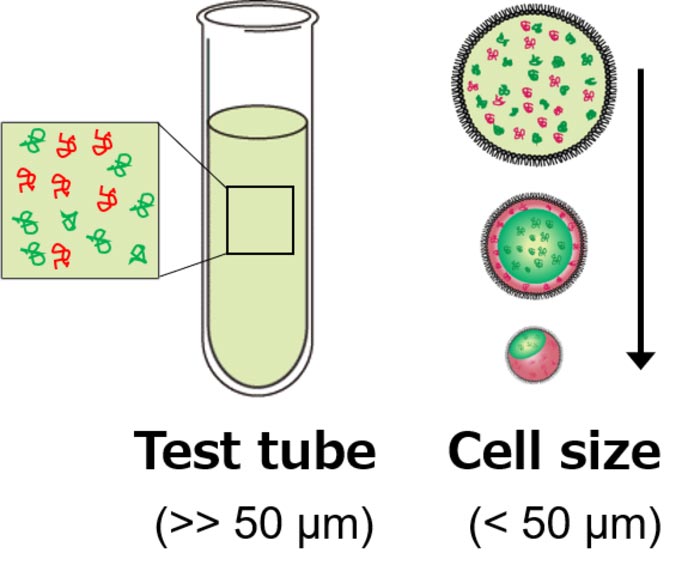Cell size regulates molecular separation

Aqueous solution of two polymers (red and green) in a test tube and in artificial cells of different sizes. In the test tube, the solution is homogeneously mixed, but in the small artificial cell, the solution separates into two phases.
Credit: © 2022 Yanagisawa et al
New research shows greater separation of molecules in smaller-sized artificial cells.
New research shows that cell size and membranes may play a key role in regulating the distribution of molecules inside cells. This discovery offers a new unconventional method for manipulating artificial cells via their size and interfacial properties, or their boundaries, instead of through molecular modification of their chemical structure. This could aid multiple industries, from cosmetics to pharmaceuticals, which want to avoid unexpected changes to the properties of artificial cells in their products, such as when creating new medicines like vaccines.
Artificial cells can be little lifesavers, such as the COVID-19 mRNA vaccine. These engineered wonders can be made to mimic the functions of biological cells and perform all sorts of tasks, from “teaching” our own cells how to respond to a virus, growing artificial skin for testing cosmetics, or making food preservatives.
However, creating and manipulating these cells comes with many challenges. “In recent years, artificial cells containing solutions (or mixtures) of multicomponent molecules have been used in cosmetic and pharmaceutical products. Although such solutions did not separate in test tubes, they sometimes separated in artificial cells, which was problematic for applications,” explained Associate Professor Miho Yanagisawa from the Graduate School of Arts and Sciences at the University of Tokyo.
This separation, called liquid-liquid phase separation (LLPS), has emerged as a fundamental mechanism for regulating biological activity in living organisms. However, the type of biomolecules that separate and the conditions under which this occurs is yet to be fully understood. This latest research published in ACS Materials Letters provides some much-needed insight.
“Conventionally, separation conditions and the degree of separation were considered to be size-independent, as long as the size of the container was about 1 micrometer, or micron (one-thousandth of a millimeter), or larger,” said Yanagisawa. However, a surprising finding of this research was that the smaller the artificial cell, the greater the degree to which separation occurred.
The idea of cell size-dependent behavior was suggested in 2012, but the details of this phenomenon remained unclear. The team at the University of Tokyo performed multiscale experiments using different-sized droplets of two polymers — short, polyethylene glycol (PEG) and long, dextran — in blends contained within a lipid membrane to create different-sized artificial cells.
“From such experiments, we realized that the membrane senses slight differences between molecules and selects the preferred molecule, which is the origin of the cell size-dependent behavior. This was the major climax of the study,” explained Yanagisawa. “We believe that this discovery offers a new method of manipulating materials via the space size and interfacial properties of the containers of artificial cells. This idea is quite different from the conventional ones through manipulation of molecular structures.”
So what next? According to Yanagisawa, “There are mainly two directions for the next step: one is toward a physical understanding and formulation of the cell-size space effects on the molecular behaviors; another is toward pharmaceuticals and cosmetics applications, using the artificial cells considering the cell-size effect.”
Journal article:
Chiho Watanabe, Tomohiro Furuki, Yuki Kanakubo, Fumiya Kanie, Keisuke Koyanagi, Jun Takeshita, Miho Yanagisawa. Cell-sized confinement initiates phase separation of polymer blends and promotes fractionation upon competitive membrane wetting,” ACS Materials Letters
https://doi.org/10.1021/acsmaterialslett.2c00404
Funding:
This work was supported by JSPS KAKENHI(JP18H01187, JP21H05871, JP21K18596, JP22H01188 [Yanagisawa]、JP20K14425 [Watanabe])、JST FOREST(JPMJFR213Y [Yanagisawa])、ACT―X(JPMJAX191L [Watanabe])
Useful Links:
Graduate School of Arts and Sciences: https://www.c.u-tokyo.ac.jp/eng_site/
Yanagisawa Lab: https://sites.google.com/g.ecc.u-tokyo.ac.jp/yanagisawa-lab/
Research Contact:
Associate Professor Miho Yanagisawa
Department of Basic Science, Graduate School of Arts and Sciences
Komaba Institute for Science, The University of Tokyo,
3-8-1 Komaba, Meguro-ku, Tokyo 153-8902, Japan
myanagisawa@g.ecc.u-tokyo.ac.jp
Press contact:
Mrs. Nicola Burghall
Public Relations Group, The University of Tokyo,
7-3-1 Hongo, Bunkyo-ku, Tokyo 113-8654, Japan
press-releases.adm@gs.mail.u-tokyo.ac.jp
About the University of Tokyo
The University of Tokyo is Japan’s leading university and one of the world’s top research universities. The vast research output of some 6,000 researchers is published in the world’s top journals across the arts and sciences. Our vibrant student body of around 15,000 undergraduate and 15,000 graduate students includes over 4,000 international students. Find out more at www.u-tokyo.ac.jp/en/ or follow us on Twitter at @UTokyo_News_en.
Journal: ACS Materials Letters
DOI: 10.1021/acsmaterialslett.2c00404
Method of Research: Experimental study
Subject of Research: Cells
Article Title: Cell-sized confinement initiates phase separation of polymer blends and promotes fractionation upon competitive membrane wetting
Article Publication Date: 24-Aug-2022
All latest news from the category: Life Sciences and Chemistry
Articles and reports from the Life Sciences and chemistry area deal with applied and basic research into modern biology, chemistry and human medicine.
Valuable information can be found on a range of life sciences fields including bacteriology, biochemistry, bionics, bioinformatics, biophysics, biotechnology, genetics, geobotany, human biology, marine biology, microbiology, molecular biology, cellular biology, zoology, bioinorganic chemistry, microchemistry and environmental chemistry.
Newest articles

Molecular gardening: New enzymes discovered for protein modification pruning
How deubiquitinases USP53 and USP54 cleave long polyubiquitin chains and how the former is linked to liver disease in children. Deubiquitinases (DUBs) are enzymes used by cells to trim protein…

Machine learning accelerates catalyst discovery
Conceptual blueprint to analyze experimental catalyst data. Machine learning (ML) models have recently become popular in the field of heterogeneous catalyst design. The inherent complexity of the interactions between catalyst…

More efficient car designs with AI
8,000 open source models for sustainable mobility. Designing new cars is expensive and time consuming. As a result, manufacturers tend to make only minor changes from one model generation to…



